
A sugarloaf was the usual form in which refined sugar was produced and sold until the late 19th century, when granulated and cube sugars were introduced. A tall cone with a rounded top was the end product of a process in which dark molasses, a rich raw sugar that was imported from sugar-growing regions such as the Caribbean and Brazil, was refined into white sugar.
CSR Limited is a major Australian industrial company, producing building products and having a 25% share in the Tomago aluminium smelter located near Newcastle, New South Wales. It is publicly traded on the Australian Securities Exchange. In 2021, it had over 3,000 employees and reported an after-tax profit of $146 million. The company has a diversified shareholding with predominantly Australian fund managers and retail owners. The group's corporate headquarters is in North Ryde, Sydney.

A sugar refinery is a refinery which processes raw sugar from cane or sugar extracted from beets into white refined sugar.

Bayway Refinery is a refining facility in the Port of New York and New Jersey, owned by Phillips 66. Located in Linden and Elizabeth, New Jersey, and bisected by Morses Creek, it is the northernmost refinery on the East Coast of the United States. The oil refinery converts crude oil into gasoline, diesel fuel, jet fuel, propane and heating oil. As of 2007, the facility processed approximately 238,000 bbl/d (37,800 m3/d) of crude oil, producing 145,000 bbl/d (23,100 m3/d) of gasoline and 110,000 bbl/d (17,000 m3/d) of distillates. Its products are delivered to East Coast customers via pipeline transport, barges, railcars and tank trucks.
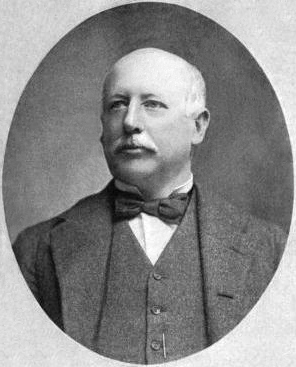
Henry Osborne Havemeyer was an American industrialist, entrepreneur and sugar refiner who founded and became president of the American Sugar Refining Company in 1891.
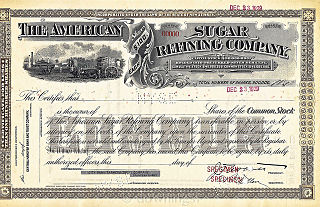
The American Sugar Refining Company (ASR) was the largest American business unit in the sugar refining industry in the early 1900s. It had interests in Puerto Rico and other Caribbean locations, and operated one of the world's largest sugar refineries, the Domino Sugar Refinery in Brooklyn, New York.

While the local use of oil goes back many centuries, the modern petroleum industry along with its outputs and modern applications are of a recent origin. Petroleum's status as a key component of politics, society, and technology has its roots in the coal and kerosene industry of the late 19th century. One of the earliest instances of this is the refining of paraffin from crude oil. Abraham Gesner, developed a process to refine a liquid fuel from coal, bitumen and oil shale, it burned more cleanly and was cheaper than whale oil. James Young in 1847 noticed a natural petroleum seepage when he distilled a light thin oil suitable for use as lamp oil, at the same time obtaining a thicker oil suitable for lubricating machinery. The world's first refineries and modern oil wells were established in the mid-19th century. While petroleum industries developed in several countries during the nineteenth century, the two giants were the United States and the Russian Empire, specifically that part of it that today forms the territory of independent Azerbaijan. Together, these two countries produced 97% of the world's oil over the course of the nineteenth century.
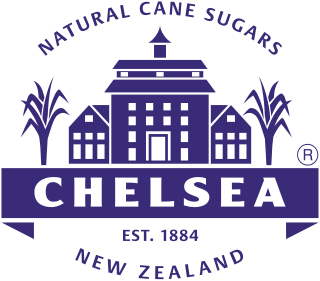
New Zealand Sugar Company Limited is a long-established business and landmark in Birkenhead, New Zealand, located on the northern shore of Auckland's Waitemata Harbour. The company is also known colloquially as "Chelsea Sugar", taking reference from the company's branded sugar "Chelsea", and the site is also colloquially known as the "Chelsea Sugar Refinery", or "sugar works".
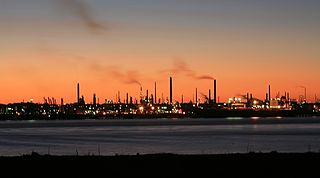
Fawley Refinery is an oil refinery located at Fawley, Hampshire, England. The refinery is owned by Esso Petroleum Company Limited, a subsidiary of Exxon Mobil Corporation, which acquired the site in 1925. Situated on Southampton Water, it was rebuilt and extended in 1951 and is now the largest oil refinery in the United Kingdom, and one of the most complex refineries in Europe. With a capacity of 270,000 barrels (43,000 m3) per day, Fawley provides 20 percent of the UK's refinery capacity. An estimated 1000 people are employed at the site.

The history of sugar has five main phases:
- The extraction of sugar cane juice from the sugarcane plant, and the subsequent domestication of the plant in tropical India and Southeast Asia sometime around 4,000 BC.
- The invention of manufacture of cane sugar granules from sugarcane juice in India a little over two thousand years ago, followed by improvements in refining the crystal granules in India in the early centuries AD.
- The spread of cultivation and manufacture of cane sugar to the medieval Islamic world together with some improvements in production methods.
- The spread of cultivation and manufacture of cane sugar to the West Indies and tropical parts of the Americas beginning in the 16th century, followed by more intensive improvements in production in the 17th through 19th centuries in that part of the world.
- The development of beet sugar, high-fructose corn syrup and other sweeteners in the 19th and 20th centuries.
Pakistan's industrial sector accounts for 28.11% of the GDP. Of this, manufacturing makes up 12.52%, mining constitutes 2.18%, construction makes up 2.05%, and electricity and gas 1.36%. The majority of industry is made up of textile units, with textiles contributing $15.4b to exports, making up 56% of total exports. Other units include surgical instruments, chemicals, and a budding automotive industry.
Pendleton Colliery was a coal mine operating on the Manchester Coalfield after the late 1820s on Whit Lane in Pendleton, Salford, then in the historic county of Lancashire, England.
The Boston and Montana Consolidated Copper and Silver Mining Company was a mining, smelting, and refining company which operated primarily in the state of Montana in the United States. It was established in 1887 and merged with the Amalgamated Copper Company in 1901. The Amalgamated Copper Company changed its name to Anaconda Copper in 1910, and became one of America's largest corporations. Historian Michael P. Malone has written, "Well financed and well managed, the Boston and Montana came to rank among the world's greatest copper companies."
Sugar Cane Growers Cooperative of Florida is a vertically integrated agricultural enterprise that harvests, transports and processes sugarcane grown primarily in Palm Beach County, Florida and markets the raw sugar and blackstrap molasses through the Florida Sugar and Molasses Exchange. The Cooperative is made up of 45 grower-owners who produce sugarcane on approximately 70,000 acres of some of the most fertile farmland in America, located in the Everglades Agricultural Area (EAA). Sugarcane grown by Cooperative members is harvested, transported and processed. The raw sugar is then marketed to one of the ASR Group's sugar refineries. The Cooperative produces more than 350,000 tons of raw sugar annually.

The Domino Sugar Refinery is a mixed-use development and former sugar refinery in the neighborhood of Williamsburg in Brooklyn, New York City, along the East River. When active as a refinery, it was operated by the Havemeyer family's American Sugar Refining Company, which produced Domino brand sugar and was one of several sugar factories on the East River in northern Brooklyn.

The Low Moor Ironworks was a wrought iron foundry established in 1791 in the village of Low Moor about 3 miles (4.8 km) south of Bradford in Yorkshire, England. The works were built to exploit the high-quality iron ore and low-sulphur coal found in the area. Low Moor made wrought iron products from 1801 until 1957 for export around the world. At one time it was the largest ironworks in Yorkshire, a major complex of mines, piles of coal and ore, kilns, blast furnaces, forges and slag heaps connected by railway lines. The surrounding countryside was littered with waste, and smoke from the furnaces and machinery blackened the sky. Today Low Moor is still industrial, but the pollution has been mostly eliminated.
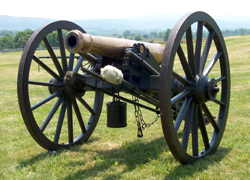
The M1841 6-pounder field gun was a bronze smoothbore muzzle-loading cannon that was adopted by the United States Army in 1841 and used from the Mexican–American War to the American Civil War. It fired a 6.1 lb (2.8 kg) round shot up to a distance of 1,523 yd (1,393 m) at 5° elevation. It could also fire canister shot and spherical case shot. The cannon proved very effective when employed by light artillery units during the Mexican–American War. The cannon was used during the early years of the American Civil War, but it was soon outclassed by newer field guns such as the 12-pounder Napoleon. In the US Army, the 6-pounders were replaced as soon as more modern weapons became available and none were manufactured after 1862. However, the Confederate States Army continued to use the cannon for a longer period because the lesser industrial capacity of the South could not produce newer guns as fast as the North.
The sugar industry of the United States produces sugarcane and sugar beets, operates sugar refineries, and produces and markets refined sugars, sugar-sweetened goods, and other products. The United States is among the world's largest sugar producers. Unlike most other sugar producing countries, the United States has both large and well-developed sugarcane and sugar beet industries. Refined sugarcane, processed sugar beet, and high-fructose corn syrup are all commonly used in the U.S. as added sugars to sweeten food and beverages.

The Amsterdamsche Stoom Suikerraffinaderij was a big Dutch sugar refining company. It produced white sugar by refining raw sugar from sugar cane. The company existed from 1833 to 1875 and was one of the most important industrial companies of Amsterdam.
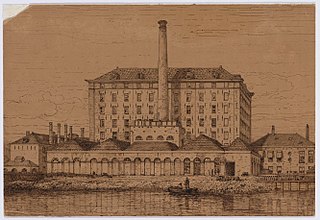
The Nederlandsche SuikerraffinaderijNV (NSR) was an Amsterdam sugar refining company that refined sugar cane to produce white sugar and other sugar products. After its demise, its main sugar refinery would become part of the "Amstel Suikerraffinaderij" and still later part of the "Wester Suikerraffinaderij".














